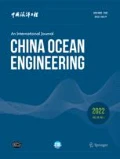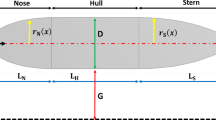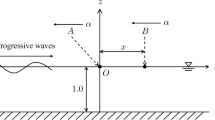Abstract
When a ship model test is performed in a tank, particularly when the tank is small and the ship model is relatively large, the blockage effect will inevitably occur. With increased ship model scale and speed, the blockage effect becomes more obvious and must be corrected. In this study, the KRISO 3600 TEU Container Ship (KCS) is taken as a model and computational fluid dynamics techniques and ship resistance tests are applied to explore the mechanism and correction method of the blockage effect. By considering the degrees of freedom of the sinkage and trim, the resistance of the ship model is calculated in the infinite domain and for blockage ratios of 1.5%, 1.8%, 2.2%, and 3.0%. Through analysis of the free surface, pressure distribution, and flow field around the ship model, the action law of the blockage effect is studied. The Scott formula and mean flow correction formula based on the average cross sectional area are recommended as the main correction methods, and these formulas are improved using a factor for the return flow velocity correction based on comparison of the modified results given by different formulas. This modification method is verified by resistance test data obtained from three ship models with different scale ratios.
Similar content being viewed by others
References
Alderf, N., Lefranĉois, E., Sergent, P. and Debaillon, P., 2010. Transition effects on ship sinkage in highly restricted waterways, Proceedings of the Institution of Mechanical Engineers, Part M: Journal of Engineering for the Maritime Environment, 224(2), 141–153.
Beck, R.F., 1981. Hydrodynamic forces caused by a ship in confined waters, Journal of Engineering Mechanics Division, 107(3), 523–546.
Chen, X., Zhu, R.C., Ma, C. and Fan, J., 2016. Computations of linear and nonlinear ship waves by higher-order boundary element method, Ocean Engineering, 114, 142–153.
Deng, H., Zhang, Z.H., Liu, J.B. and Gu, J.N., 2014. Nonlinear effects on hydrodynamic pressure field caused by ship moving at supercritical speed in shallow water, Ocean Engineering, 82, 144–149.
Enger, S., Peric, M. and Peric, R., 2010. Simulation of flow around KCS-hull, Proceedings of the A Workshop on CFD in Ship Hydrodynamics, Gothenburg, Sweden.
Gourlay, T., 2008. Slender-body methods for predicting ship squat, Ocean Engineering, 35(2), 191–200.
Gross, A. and Watanabe, K., 1972. On blockage correction, Proceedings of the 13th ITTC, Hamburg Berlin, Germany, pp. 209–240.
Guo, C.Y., Kan, Z., Zhao, D.G. and Wu, T.C., 2016a. Numerical study on the blockage effect of a towing tank considering ship motion, Journal of Harbin Engineering University, 37(12), 1619–1624. (in Chinese)
Guo, C.Y., Wu, T.C., Zhang, Q. and Gong, J., 2016b. Numerical simulation and experimental research on wake field of ships under off-design conditions, China Ocean Engineering, 30(5), 821–834.
Hirt, C.W. and Nichols, B.D., 1981. Volume of fluid (VOF) method for the dynamics of free boundaries, Journal of Computational Physics, 39(1), 201–225.
Hunt, J.C.R., Wray, A.A. and Moin, P., 1988. Eddies, streams, and convergence zones in turbulent flows, Proceedings of the 1988 Summer Program, Center for Turbulence Research, Stanford, pp. 193–208.
Jachowski, J., 2008. Assessment of ship squat in shallow water using CFD, Archives of Civil and Mechanical Engineering, 8(1), 27–36.
Kim, W.J., Van, S.H. and Kim, D.H., 2001. Measurement of flows around modern commercial ship models, Experiments in Fluids, 31(5), 567–578.
Larsson, L., Stern, F. and Visonneau, M., 2014. Numerical Ship Hydrodynamics: An Assessment of the Gothenburg 2010 Workshop, Springer, Netherlands.
Lataire, E., Vantorre, M. and Delefortrie, G., 2012. A prediction method for squat in restricted and unrestricted rectangular fairways, Ocean Engineering, 55, 71–80.
Ma, S.J., Zhou, M.G. and Zou, Z.J., 2013. Hydrodynamic interaction among hull, rudder and bank for a ship sailing along a bank in restricted waters, Journal of Hydrodynamics, 25(6), 809–817.
Menter, F.R., 1994. Two-equation eddy-viscosity turbulence models for engineering applications, AIAA Journal, 32(8), 1598–1605.
Millward, A., 1996. A review of the prediction of squat in shallow water, Journal of Navigation, 49(1), 77–88.
Schijf, J.B., 1949. Protection of embankments and bed in inland and maritime waters, and in overflow or weirs, Proceedings of the 17th International Navigation Congress, Permanent International Association of Navigation Congresses, Lisbon, Portugal, pp. 61–78.
Scott, J.R., 1970. A Comparison of four blockage correctors, Proceedings of the 13th International Towing Tank Conference, Volume II, Berlin.
Sheng, Z.B. and Liu, Y.Z., 2004. Watercraft principle: Ship resistance, Chapter 1, Causes and Classification of Ship Resistance, pp. 153–155.
Tamura, K., 1975. “Blockage correction” proceedings, Proceedings of 14th International Towing Tank Conference, Volume III, Ottawa.
Wang, X.G., Zou, Z.J., Yu, L. and Cai, W., 2015. System identification modeling of ship manoeuvring motion in 4 degrees of freedom based on support vector machines, China Ocean Engineering, 29(4), 519–534.
Wilcox, D.C., 1998. Turbulence modeling for CFD, United States of America by Griffin Printing, Glendale, California, pp. 84–87.
William Jr., H. and Pope, A.R., 1984. Low-Speed Wind Tunnel Testing, second ed., Wiley, New York, pp. 133–135.
Wu, B.S., 2007. On geometric parameters in uncertainty analysis of measurement in ship model test, Journal of Ship Mechanics, 11(3), 363–372.
Xie, K.Z., Zhou, Z.Q., Song, J.J., Shen, H.Y. and Ye, B.J., 1978. The experiment study of blockage effect of the tank, Journal of Shanghai Ship and Shipping Research Institute, 1(2), 1–27. (in Chinese)
Yao, Z.Q., Shen, H.C. and Gao, H., 2013. A new methodology for the CFD uncertainty analysis, Journal of Hydrodynamics, 25(1), 131–147.
Zaghi, S., Muscari, R. and Di Mascio, A., 2016. Assessment of blockage effects in wind tunnel testing of wind turbines, Journal of Wind Engineering and Industrial Aerodynamics, 154, 1–9.
Zhang, Z.H., Deng, H. and Wang, C., 2015. Analytical models of hydrodynamic pressure field causing by a moving ship in restricted waterways, Ocean Engineering, 108, 563–570.
Zhou, G.L., 2002. Uncertainty Analysis of Ship Model Towing Resistance Experiment, MSc. Thesis, Harbin Engineering University, Harbin. (in Chinese)
Zhou, M.G., Zou, Z.J. and Yao, J.X., 2013. Prediction of ship squat in restricted waters, Journal of Ship Mechanics, 17(6), 625–634. (in Chinese)
Zou, L. and Larsson, L., 2013a. Numerical predictions of ship-to-ship interaction in shallow water, Ocean Engineering, 72, 386–402.
Zou, L. and Larsson, L., 2013b. Computational fluid dynamics (CFD) prediction of bank effects including verification and validation, Journal of Marine Science and Technology, 18(3), 310–323.
Author information
Authors and Affiliations
Corresponding author
Additional information
Foundation item: This research was financially supported by the National Natural Science Foundation of China (Grant No. 51679052), the Natural Science Foundation of Heilongjiang Province of China (Grant No. E2018026) and the Defense Industrial Technology Development Program (Grant No. JCKY 2016604B001).
Rights and permissions
About this article
Cite this article
Guo, Cy., Xu, P., Wang, C. et al. Numerical and Experimental Study of Blockage Effect Correction Method in Towing Tank. China Ocean Eng 33, 522–536 (2019). https://doi.org/10.1007/s13344-019-0050-4
Received:
Revised:
Accepted:
Published:
Issue Date:
DOI: https://doi.org/10.1007/s13344-019-0050-4




